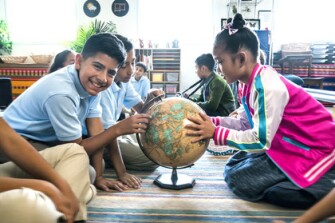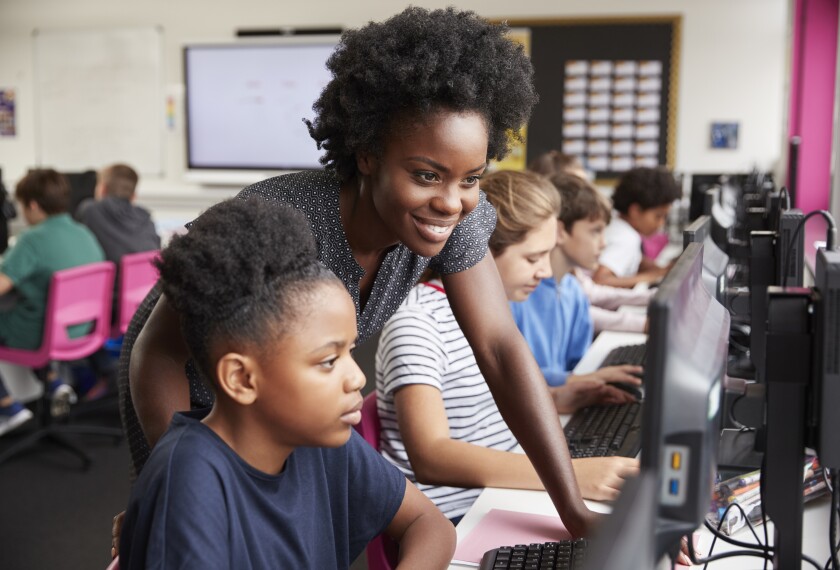Editor’s Note: Recognizing the perspectives of others has never been more important. Today, Jane Chadsey of Educurious and Kristin Ohnstad of The KIND Foundation share how to begin building these skills in students. Dive deeper into this topic with the authors this Thursday, November 2 at 8pm Eastern time during #Globaledchat on Twitter. (Just search for #Globaledchat to join the conversation).
What is needed more than ever is a laser-like focus on the kinds of human beings that we are raising and the kinds of societies—indeed, in a global era, the kind of world society—that we are fashioning. - Howard Gardner
It is our essential responsibility as educators to know what to teach, how to reach all of our students, and how to measure student learning. Raising academic standards and achievement in mathematics, science, literacy, and social studies are important for young people to thrive. Further, the reason many educators teach—why we get out of bed in the morning—is to help develop human beings who make the world better.
Anthony Jackson writes, “These are necessary strategies for change (raising academic standards, evaluating teaching more precisely, etc), but insufficient to create the citizens, workers, and leaders our nation needs in the 21st century. Missing in this formula for a world-class education is an urgent call for schools to produce students that actually know something about the world—its cultures, languages and how its economic, environmental and social systems work.”

Knowing something about the world requires, in part, forming connections with one another, especially with those we perceive as different from us. Building connections with people across geographies and cultures is key to building diverse communities that are able to achieve significant, shared goals and address growing global challenges.
Imagine if we send young people out into the world who are persistently curious, and have the capacity to consider their own perspective while listening to and understanding the perspectives of others? If we raise young people who effectively communicate their ideas and take action on the issues they care about because they have the disciplinary knowledge they need in mathematics, science, social studies, and literacy to solve the problems our world faces? What would the world be like? What would we hear? What would we see? What would we do differently? What would we achieve together?
This is a conversation more and more educators and leading education organizations are having. It’s important that we share how to move from talk to action, and collaborate in practicing global competence every day. Here are just a few ideas and examples of such efforts in classrooms, schools, and organizations that may be useful to you:
1. Make Virtual Exchange a Standard Part of the School Day
Telling and sharing stories is key to expanding young people’s world views beyond their classrooms and communities. One new initiative we’ve been involved in is Empatico, a free online tool and initiative of The KIND Foundation, which helps young people discover what life is like for their peers around the globe by matching classrooms through an easy-to-use online platform. The platform combines live video technology, seamless connections (meaning teachers are automatically matched and can communicate within the platform), and high-quality activities that are research-based and built specifically for 8-10-year-olds.
Empatico activities (called Spark activities) are designed to promote greater understanding of similarities and differences and help students practice listening, sharing, reflecting, and understanding the perspective of others. Spark activities are 2-3 hours in length and can be integrated into existing curriculum—it’s like a free global perspective “plug in” for teachers and students. Empatico enables teachers to weave in connections with other students from around the world on a regular, frequent basis, so that perspective building becomes a standard way students learn.
2. Engage in Problem- and Project- Based Learning
Project-based Learning (PBL) is a dynamic approach to teaching in which students explore real-world problems and challenges. Students are inspired to obtain a deeper knowledge of the subjects they are studying by applying skills and knowledge to solving a problem that is important to their community or the world using knowledge of the subjects they are studying. In PBL classrooms, students weigh perspectives, communicate ideas, and take action, while applying disciplinary and interdisciplinary expertise. Educurious is working with schools around the country to apply core academic skills to solving local and global problems through PBL connecting classrooms to experts in the field students are studying to ensure relevancy to real world, global problems.
For example, in Seattle, Washington, middle school social studies teachers are working with Educurious in partnership with the Port of Seattle to develop PBL units that explore Port-related careers and challenges. Here’s one of the problems they’re investigating: Container ships entering the Port of Seattle are increasing in size because of expanding global trade and the Port doesn’t have a dock big enough to receive them. To remain competitive, the Port must decide how and when to expand an existing dock. Multiple stakeholders are involved, including local tribes, migrating salmon, environmentalists, businesses, and residents. Each of these stakeholders has an important perspective that needs to be heard and addressed. In this local and global issue, students will learn about those perspectives before they make a recommendation to the Port of Seattle’s commissioners. What local issues might your students explore?
A good place to learn about the research base for PBL is Lucas Education Research. In What is Rigorous Project Based Learning?, authors AnnMarie Baines and Angela Haydel DeBarger call out four pillars of rigorous PBL that provide insight into how it can provide a methodology for global learning. For practical advice on how to get started with PBL in your classroom Edutopia is a free, go-to resource. Five Keys to Rigorous Project-Based Learning is a good place to get started.
3. Use Dialogue Circles as a Regular Classroom Practice
Dialogue (or Reflection) Circles are increasingly being used in classrooms and are aimed at building collaboration, respect, perspective taking, and increasing the ownership of students. This helps provide a safe, supportive space where all school community members can talk about sensitive topics, work through differences, build consensus, and solve problems. Reflection circles take many forms and can focus on different aspects of social and cultural communication.
Central to any reflection circle is both speaking and listening because mutual understanding lays the groundwork for deeper, more meaningful discussion. Young people benefit from practicing listening and perspective taking. Social norms significantly influence how a child perceives and interacts with others. If a child believes his teacher and peers support relationships, he or she is more likely to seek friendship and develop positive perceptions about other students and their culture or countries. Glenview Elementary School offers an example of how dialogue circles can be used effectively. Empatico activities also end with a reflection circle and PBL includes reflecting on your project work. What went well? How did your team work together? What could be improved?
These are just a few examples of how educators can put these practices into action. What are you doing to prepare young people for success in an interconnected world? How are your students learning to establish their own perspectives and hear and understand the perspectives of others in order to create a more compassionate, kind, global community?
Connect with Empatico, Educurious, and the Center for Global Education on Twitter.
Image used with permission of the photographer, Chris Willard.




